 A year and a half into sole ownership of the bookstore—after twenty years with a co-owner—I’ve found my business behavior transforming. Once, I was a kind of groundskeeper with four or five bookstore “gardens” to tend. I’ve now become a lighthouse keeper, needing to shine a beam on every aspect of the store in a never-ending revolution of shifting attention. My gaze is steady when it lands on an area: bill paying, event planning, frontlist buying, budgeting, customer attention, marketing, display, new programming, backlist restocking, returns, donations, and so on. But then the lighthouse beam must move to the next area, leaving the rest in the dark until the light sweeps back in again. I have wonderful staff to help with these islands of store needs, but I have to gaze on all of them regularly in order to run a tight … lighthouse?
A year and a half into sole ownership of the bookstore—after twenty years with a co-owner—I’ve found my business behavior transforming. Once, I was a kind of groundskeeper with four or five bookstore “gardens” to tend. I’ve now become a lighthouse keeper, needing to shine a beam on every aspect of the store in a never-ending revolution of shifting attention. My gaze is steady when it lands on an area: bill paying, event planning, frontlist buying, budgeting, customer attention, marketing, display, new programming, backlist restocking, returns, donations, and so on. But then the lighthouse beam must move to the next area, leaving the rest in the dark until the light sweeps back in again. I have wonderful staff to help with these islands of store needs, but I have to gaze on all of them regularly in order to run a tight … lighthouse?
Being a lighthouse keeper is at odds with the way our vendors are set up, of course. The big publishers have entire departments focused on a single mission, such as collecting payments. We, on the other hand, have fifteen departments each managed by … us. If we are a few days late with a $27 payment and a credit rep calls in a panic, I chuckle to myself a little, because I imagine them thinking of a bookstore as a segmented business like a publishing house. I suspect they don’t envision just how many hats (to switch metaphors) we wear at once. So I’ll reassure them, reminding them that we’ve been good, reliable, paying customers for 21 years and don’t plan to stop now, that I’ll pop their check in the mail pronto, and I thank them for their phone call, which is a helpful nudge to get the lighthouse beam trained once again on the check-drafting portion of my job. (I feel it’s important to tell you that I am usually prompt with my bills and am foiled only when my revolving beam is snagged on a kraken or some such momentous distraction.)
In honor of the lighthouse school of bookselling, here are a few of my favorite lighthouse titles:
 Hildegarde H. Swift and Caldecott Award-winning artist Lynd Ward teamed up to write an endearing and enduring tale of the real lighthouse underneath the George Washington Bridge in New York City. Written in 1942, The Little Red Lighthouse and the Great Gray Bridge was a big hit, and when, just nine years later, plans were afoot to decommission the little lighthouse, fans of the book were outraged and the lighthouse was saved. Hooray! I first discovered this book when I was librarian at the City & Country School in Manhattan in the early 90s. It was a favorite of the children’s and mine back then, some fifty years after it was written, and I’m sure it is still a favorite at the school today. Customers who come into the store knowing the book are always delighted to see it on the shelf. I miss the beautiful hardcover edition, but, happily, Houghton Mifflin Harcourt does keep the paperback in print.
Hildegarde H. Swift and Caldecott Award-winning artist Lynd Ward teamed up to write an endearing and enduring tale of the real lighthouse underneath the George Washington Bridge in New York City. Written in 1942, The Little Red Lighthouse and the Great Gray Bridge was a big hit, and when, just nine years later, plans were afoot to decommission the little lighthouse, fans of the book were outraged and the lighthouse was saved. Hooray! I first discovered this book when I was librarian at the City & Country School in Manhattan in the early 90s. It was a favorite of the children’s and mine back then, some fifty years after it was written, and I’m sure it is still a favorite at the school today. Customers who come into the store knowing the book are always delighted to see it on the shelf. I miss the beautiful hardcover edition, but, happily, Houghton Mifflin Harcourt does keep the paperback in print.
This April brought a gorgeous new lighthouse picture book, which also happens to be illustrated by a Caldecott medalist. Sophie Blackall’s charming Hello, Lighthouse (pictured at the top of this post) instantly became a staff favorite. Telling the story of a lighthouse through time, from a new keeper’s first day through his last, it’s the kind of book children love, with appealing details of old-fashioned life, the drama of danger at sea and the task of keeping it at bay, and the cycles of seasons and change over the years. This book absolutely flies off the shelf as soon as we restock it.
 Another favorite is Anita Lobel’s 2000 release, One Lighthouse, One Moon (Greenwillow), which made our store’s annual top picks newsletter that year. Chalk up a third lighthouse picture book to a Caldecott (Honor) medalist! (Note that the Caldecott awards and honors weren’t bestowed on the lighthouse books themselves, but I do think it’s interesting that so many fine artists are drawn to illustrating lighthouses.) Lobel’s is a deceptively simple-seeming concept book in three parts that invites young children into a lovely counting book also involving seasons, colors, days of the week, and months of the year.
Another favorite is Anita Lobel’s 2000 release, One Lighthouse, One Moon (Greenwillow), which made our store’s annual top picks newsletter that year. Chalk up a third lighthouse picture book to a Caldecott (Honor) medalist! (Note that the Caldecott awards and honors weren’t bestowed on the lighthouse books themselves, but I do think it’s interesting that so many fine artists are drawn to illustrating lighthouses.) Lobel’s is a deceptively simple-seeming concept book in three parts that invites young children into a lovely counting book also involving seasons, colors, days of the week, and months of the year.
Two adventure-filled lighthouse picture books are Birdie’s Lighthouse by Deborah Hopkinson, illustrated by Kimberly Bulcken Root (Aladdin), and Storm’s Coming! by Margi Preus, illus. by David Geister (Minnesota Historical Society Press). In the first book, tall and skinny like a lighthouse itself, a young girl keeps the lamp lit during a storm when her father, the keeper, is taken ill. In the second, a contemporary girl—also the daughter of a lighthouse keeper—notices nature’s small signs of storm warning in the changed behavior of birds, insects, and even flowers outside, and must race to alert her father to the danger.

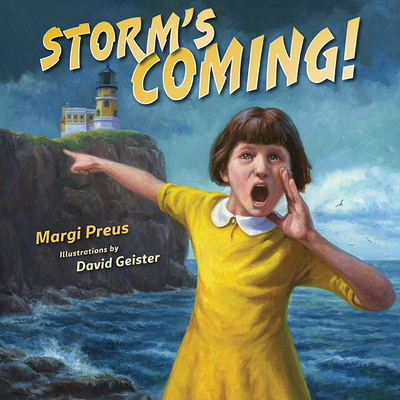
Chapter book readers can dive into the world of Cynthia Rylant’s Lighthouse Family series, which begins with The Storm. Here, Pandora the cat becomes a lighthouse keeper and saves the life of a seafaring dog (appropriately named Seabold). The rest of the series follows Pandora, Seabold, and their little rescued mice family in further adventures. Adorable, especially with the pretty illustrations by Preston McDaniels. 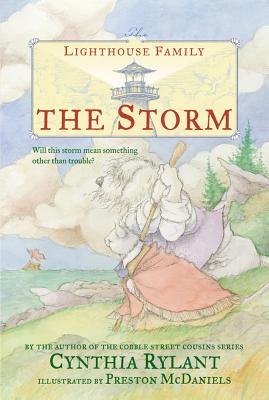
Jumping to the adult realm, there’s a tie for first place for my favorite lighthouse novels:
One is Sena Jeter Naslund’s Ahab’s Wife, which begins with the protagonist in her teens, running away from a ruinous father to live with relatives in a lighthouse in New Bedford, Mass.
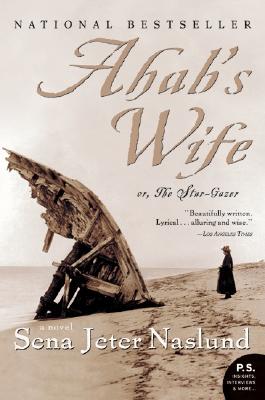
The other is Howard Norman’s fabulous National Book Award finalist The Bird Artist, in which a solitary 1911 Newfoundland illustrator of birds confesses to the murder of the lighthouse keeper.
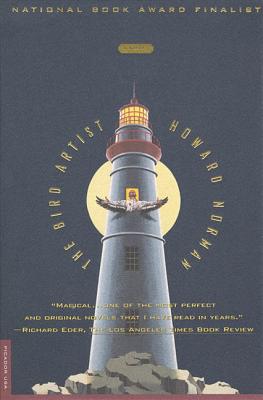
(Stumper: There’s another one I loved but cannot find. When we opened the store in the mid-90s, we loved to recommend an adult fiction title that I could swear was about the real-life 19th-century lighthouse hero, Grace Darling, who was instrumental in helping to save the lives of shipwrecked sailors. I cannot for the life of me remember the title of that novel. Anyone? If it doesn’t surface, at least there is another novel about Grace D. coming out this October from William Morrow & Co: Hazel Gaynor’s The Lighthouse Keeper’s Daughter.)
No lighthouse roundup would be complete without Virginia Woolf’s To the Lighthouse, of course, but I have to confess that I have never read it. I don’t know how I can call myself a former English major when that canonical novel eluded me, but there you have it.
It’s not surprising that there are so many great stories about lighthouse keepers. What is surprising, however, is that they seem to sire only daughters. Has anyone written about a lighthouse keeper’s son?
What are your favorite lighthouse stories?
From my perch at the lighthouse lamp, here’s wishing us all a summer that looks more like this:
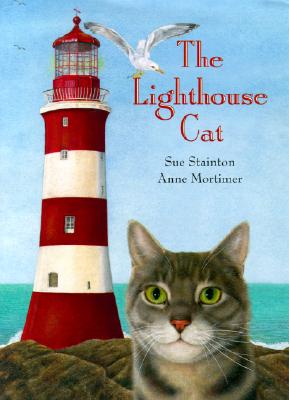
than this:


Here’s one more for your list: “Miss Colfax’s Light” (2016 Sleeping Bear Press). Thanks!
Grace by Jill Paton Walsh? It was published by FS&G in 1992.
Would it be Grace by Jill Paton Walsh, by any chance?
Our library has it in juvenile fiction, but some of the editions in Worldcat show it as general audience.
One of my favorite in the Dear America series was A Light in the Storm: The Civil War Diary of Amelia Martin. This volume, written by Karen Hesse and published in 1999, followed the (apparently ubiquitous) lighthouse keeper’s daughter as she tried to bridge the gap between her Northern father and Southern-sympathizing mother. I’m glad I have an old copy stashed away with one of the original covers that featured paintings.
It might be Grace by Jill Paton Walsh! I do love her work. Off to reacquaint myself with that one. Thanks!
One of my absolute favorites as a child was “Keep the Lights Burning, Abbie” by Peter and Connie Roop. Thanks for this roundup– I’m excited to look into these!